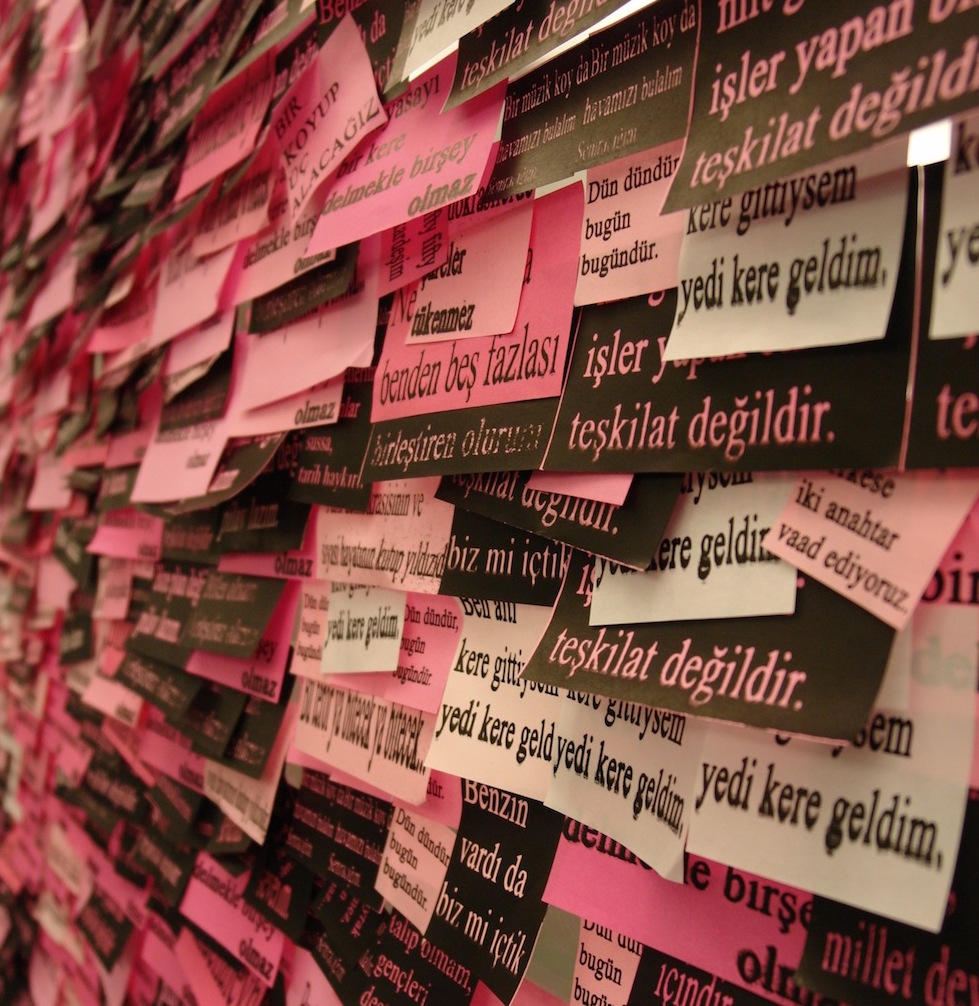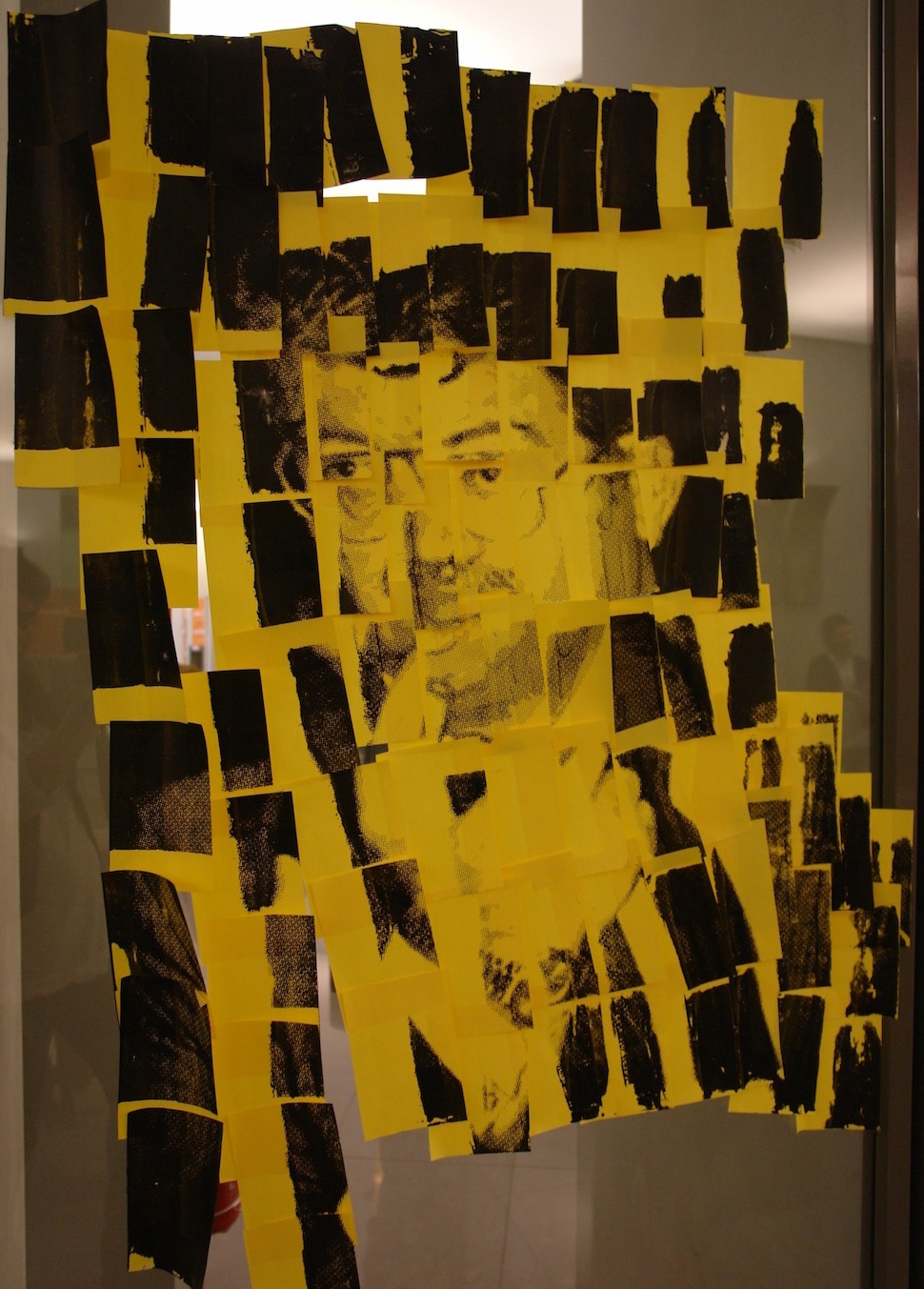HANDLE WITH CARE
OCT – DEC, 2010
HANDLE WITH CARE
Uni-Credit Studio, Milan, Italy
Artists:
Dusica Drazic | Vikenti Komitski | Ardan Ozmenoglu
Curators:
Maja Ciric | Vera Mlechevska | Isin Önol
Exhibition Info: Carte Blanche #2: Handle with Care
Conversation between Ardan Özmenoglu and Isin Önol
Isin Onol Ardan, for a long time you have been executing your artwork by printing on post-it papers with various techniques. Even if the material seems the same, your works differ with the context of the images. If you look back, how would you consider these differences? For instance, you have printed big portraits of sultans and prime ministers. Where do you think your work is heading to? Are you going to continue with ‘post-it’s or will you somehow give up?
Ardan Ozmenoglu I believe that every new work that I produce carries the same uniqueness despite the change in context. Post-it notes are always going to be a part of my artwork. Just like these special papers can stick to everywhere, I have also stick to them. But of course I didn’t detach myself from other media and materials. One point that intrigues the viewers about my work is the harmony of ‘the idea’ with the technique and material I use.

I.O. Some months ago, you have exhibited some famous Turkish political figures that we know from the 90’s and their unforgettable promises and propaganda speeches before the elections. Your post-it technique that forms the basis of your art is probably reveals itself at best with this exhibition. The post-it notes metaphorically replace the temporary and superficial nature of the posters, the promises and slogans that had been used before all these elections. What you did was just to present these images to the viewers, you have not altered any of its language. But the exhibition gave the impression that you somehow told a joke. Now this material will be exhibited in Italy in a foreign country within a different context. What do you think will the reactions of the viewers in another country be while the context is so local?
A.O. According to my understanding, these are the types of works that are pretty eye-catching and make the viewers look further. I have produced these works of white lies and 90’s Turkish political arena in a studio in Vienna where I shared the space with two artists from two different backgrounds. Both artists were first interested in the aesthetics of the works and then wondered about the story. I am sure that in Italy, the viewers would also have the same interest both in terms of imagery and context.

I.O. You are looking at politics from a very de-politic standpoint and represent a perspective of 80s children. On the other hand, to present this de-political perspective is indeed a very political decision. Being a child from the same era, I find it very intimate that the memories of a child is evoked as the same way as you do it today. It was nearly impossible for us children to understand their political views so these figures were sole images for us. And for a person who wants to stay away from local politics, this perception does not differ so much as an adult. I find it very political that you eliminated to use or rather presented the absent images of Tayyip Erdogan who has already been very frequent subject of comic magazines with his rude speeches and blunders as well as Deniz Baykal, other cult character who has been opponent to him and recently had to resign from his position. What was the reason for this hesitancy for keeping them away from your work?

A.O. I get excited to make art that ask questions and add another dimension to daily experience but on the other I’d rather keep those big questions as simple as possible. And in fact my answer lies very subtle in your own question. Perhaps my decision not to use today’s political figures is because I don’t even want to think about them.

I.O. Ahead, an important referendum (12 September 2010) is awaiting to give form to the future of Turkish politics. And as always there are a lot of polemics. After the military coup, on 12 September 1980, the referendum was speculatively announced to be accepted although the majority of the people voted for “no”. Now changes are proposed for this 1980 Constitution but the people who said ‘no’ in 1980 still plan to say no just because they do not trust the political party that proposes the changes. ‘Why yes?’ ‘Why no?’ debates are all over published media and the Internet. On the other hand, I am sure that by now, cities are bombarded with posters, slogans and visual distractions. Living through this right now, what do you collect for your own art?
A.O. I try to collect all the materials – the flags, posters, and even music recordings that are related to this referendum from streets and squares. It is pretty surprising to see the collective data when all the ‘yes’s and ‘no’s come together. The whole situation and all this material are the ultimate proofs for the reality. One should never forget that, there is someone who knows but there is also another one who knows it better.

I.O. When I visited you at your studio last winter in Vienna, where you participated in artist in residence programme, you were preparing work for three exhibitions. You remember that I felt really excited to help you with some of your prints but I couldn’t really stand doing all this tedious work and I had to quit so soon. Talking about the process, both the printing of these small papers and installing them in the exhibition space requires hard effort and patience. What does this process mean to you?
A.O. This creation process is physically and psychologically quite demanding but it is also fun for me. I have a very disciplined way of working in my studio and I believe that is a quality that every successful artist should have. I know that at the end of every exhibition, the works of art that I had produced derive from the excellence of this process. And talent is a secret pray.

photographs by the artist © Ardan Özmenoglu
